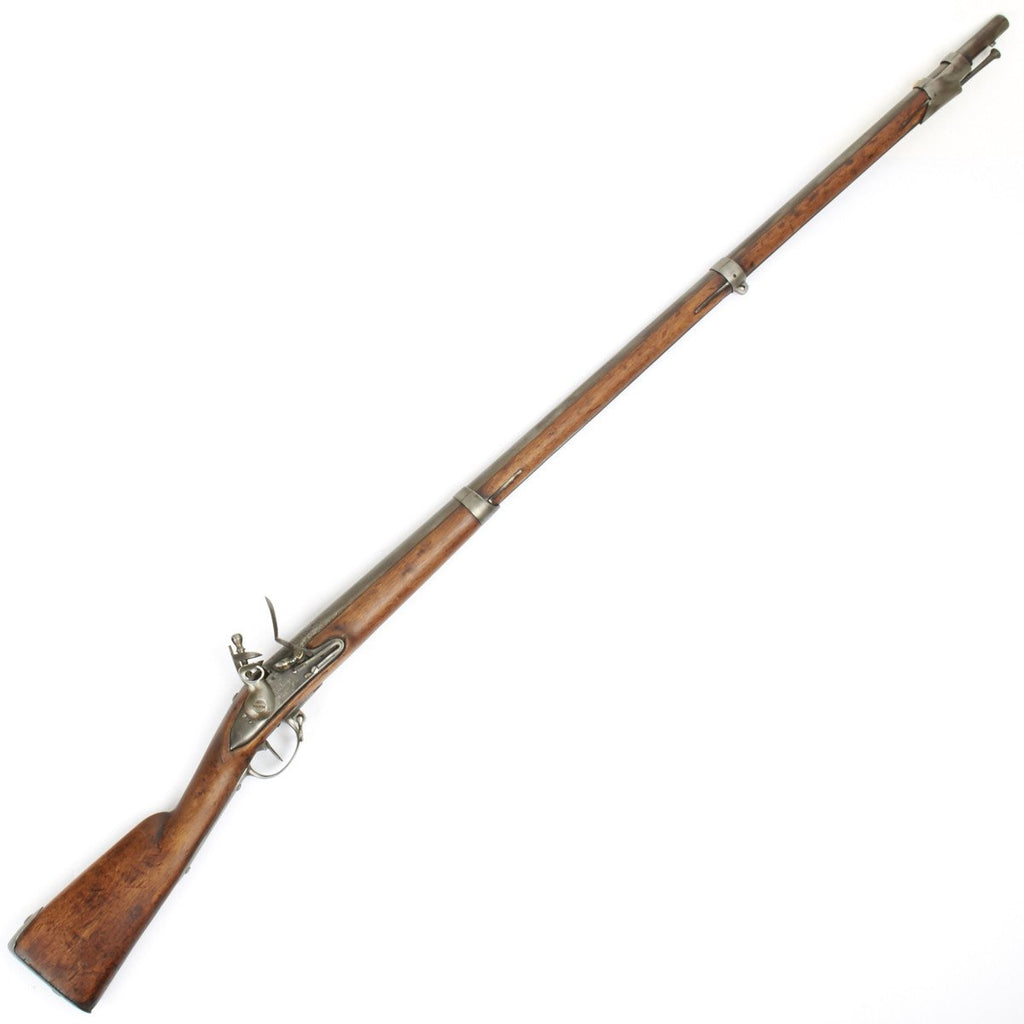Item Description
Original Item: Only One Available. This is a perfectly standard French Flintlock .69 caliber infantry musket of the Model of 1777 made at the National Manufacturing Arsenal at MAUBEUGE, the old arsenal city in the North of France. It is offered in near excellent cleaned and complete condition (minus front sling swivel).
Production had been centered there for hundreds of years until 1838 when the French government closed the facility as being too close to the German border and moved the center of Arms manufacture to St. Etienne and other centers in Central France.
Fitted with the standard 44.5 barrel and complete with all iron mounts. The walnut stock in excellent shape the musket comes complete with a well-marked flintlock mechanism.
French muskets saw service in America throughout the 18th century from before the French and Indian Wars, The War of Independence and the War of 1812. Commonly referred to as the
Charleville Muskets for another National French Arsenal these were the basis of the U.S.'s own early Flintlock Musket models.
History of the Charleville Musket-
In 1717, a flintlock musket for the French infantry was standardized for hunting. This became the first standard flintlock musket to be issued to all troops. While it is more correctly called a French infantry musket or a French pattern musket, these muskets later became known as "Charleville muskets", after the armory in Charleville-Mézières, Ardennes, France. The standard French infantry musket was also produced at Tulle, St. Etienne, Maubeuge Arsenal, and other sites. While technically not the correct name for these muskets, the use of the name Charleville dates back to the U.S. Revolutionary War, when Americans tended to refer to all of the musket models as Charlevilles. It should be noted that the naming of these muskets is not consistent. Some references only refer to Model 1763 and later versions as Charleville muskets, while other references refer to all models as Charlevilles.
Model 1777, the design of the stock was again modified for the Model 1777, with a cheek rest cut into the inboard side of the butt. The Model 1777 also featured a slanted brass flash pan and bridle, and a modified trigger guard with two rear finger ridges.
Charleville muskets had a smooth bore barrel. Rifles were more accurate than smooth bore muskets, but military commanders favored smooth bores on the battlefield, since the round from a rifle had to fit tightly into the barrel, and became very difficult to load after a few shots because the black powder used at the time quickly fouled the barrel. The longer range and better accuracy of the rifle was also considered to be of little value on a battlefield that was quickly obscured by black powder smoke. Like all smooth bore muskets, the Charleville musket was only accurate to about 50 to 100 meters.
The Charleville's .69" (17.5mm) caliber barrel was slightly smaller than its main competitor, the .75 caliber Brown Bess produced by the British. The smaller round was intentionally chosen to reduce weight in the field, but still had enough mass to be effective as a military round. The Charleville's stock was usually made out of walnut.
Charleville muskets were not used in battle like a modern rifle. Instead, Charleville muskets were fired in mass formations. In modern warfare, bayonets are considered to be last-ditch weapons, but in the days of the Charleville musket, they played a much more significant role on the battlefield, often accounting for roughly a third of all battlefield casualties. Muskets played a dual role on the battlefield, being used as a ranged weapon at a distance, and also being used as a pike type weapon in close hand-to-hand combat. This use as a pike dictated the Charleville's general length and weight. A shorter weapon could not be used as a pike, and its weight was a balance between being heavy enough to be used as a pike or club, but light enough to be carried and used by general infantrymen.
The rate of fire depended on the skill of the soldier, which was typically about 3 shots per minute. The Charleville's barrel was held into place by three barrel bands. This made the Charleville sturdier than the British Brown Bess musket, which used pins to hold the barrel in place. The butt of the Charleville's stock was sometimes referred to as the "patte de vache" (French for "cow's foot"), as its shape was designed to be used as a club in hand-to-hand combat.
Charleville muskets were muzzle loaded, and used a flintlock firing mechanism. They typically fired a round ball, but could fire other ammunition such as buck and ball or shot.
- This product is available for international shipping.
- IMA considers all of our antique guns as non-firing, inoperable and/or inert. Title 18, U.S. Code, Section 921(a)(16) defines antique firearms as all guns made prior to 1899. This law exempts antique firearms from any form of gun control or special engineering because they are not legally considered firearms. No FFL, C&R or any license is required to posses, transport, sell or trade Antique guns. All rifles and muskets sold by IMA that were manufactured prior to 1899 are considered Antiques by the US BATF (United States Bureau of Alcohol, Tobacco & Firearms). Therefore, all of IMA's Antique guns may be shipped to all US States and most nations around the world.
These antique guns are not sold in live condition. They are sold as collector’s items or as wall hangers. Any attempt at restoring an antique gun to be operational is strongly discouraged and is done so at the risk of the customer. By purchasing an antique gun from IMA you thereby release IMA, its employees and corporate officers from any and all liability associated with use of our Antique guns.
Pre-1899 Manufacture, no licenses required, allowed to ship to almost any deliverable address across the globe.
- Not eligible for payment with Paypal or Amazon


























